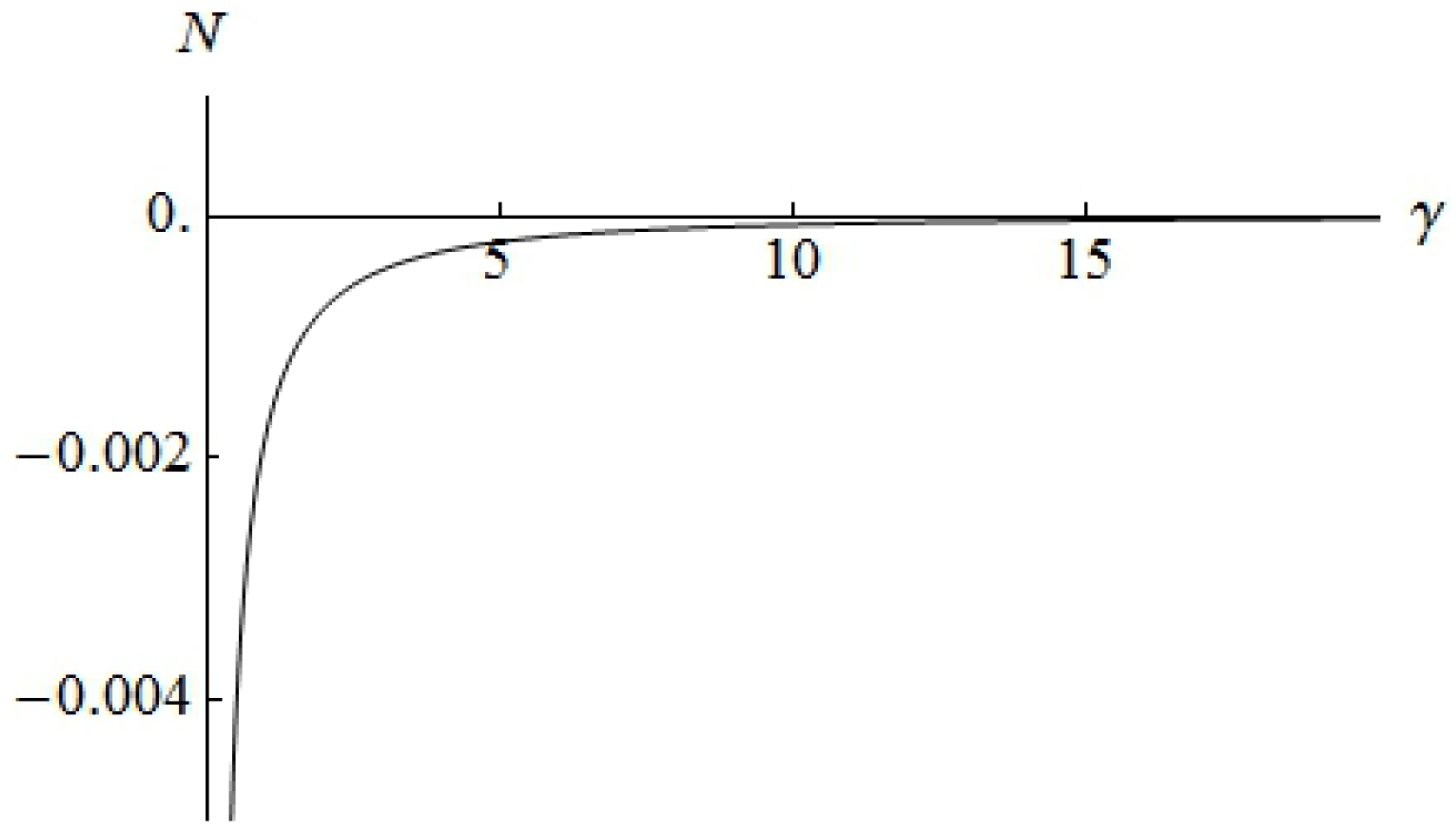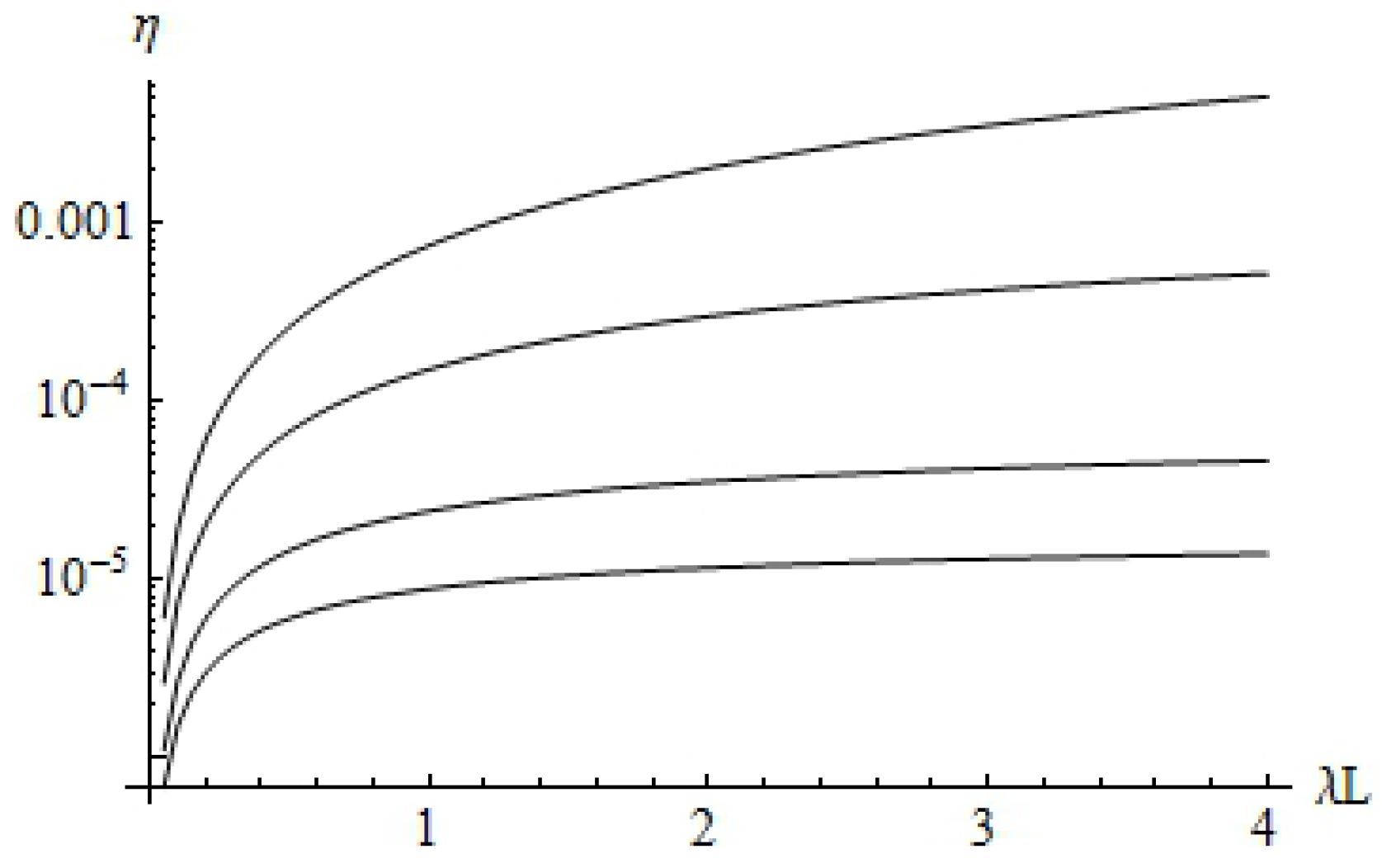1. Introduction
In its initial formulation, the Casimir effect is the attraction between conducting plates due to the vacuum fluctuations of the electromagnetic field [
1]. It was later generalized to the dispersion force between dielectric half spaces [
2]. The evolution went on to include temperature of the plates and dissipation (see, e.g., [
3]). The material of the plates was modeled by dipoles and/or polarization fields. An equivalent, perhaps more general, approach is macroscopic quantum electrodynamics [
4,
5,
6]. It is a common feature of these approaches that the resulting Hamiltonian is quadratic in the fields. First papers going beyond this were on the Casimir effect with respect to graphene [
7,
8,
9]. Here, the coupling is the usual electrodynamic one,
, which is a vertex with three lines, and the corresponding Hamiltonian is no longer quadratic. However, since the spinor field describing the electrons in graphene is confined to a two-dimensional surface in three-dimensional space, the reflection coefficients could be expressed explicitly in terms of the polarization tensor of the electrons calculated within otherwise unconstrained (2 + 1)-dimensional field theory of the spinor field representing the electrons. Now, if we assume two half spaces wherein a spinor or another field is confined, we have a (3 + 1)-dimensional field theory restricted to two half spaces. We think that there is an upcoming interest in such type of calculations, which comes from the high precision measurement of dispersion forces (up to femto Newton) and that there is a challenge to account for internal dynamical properties of the interacting bodies in more detail. This means that, in future, one will be tempted to calculate Casimir forces between fields inside the bodies, electron-hole, and phonon fields, for instance.
In the present paper, we consider the simplest model of the mentioned type consisting of a scalar field
in the whole space, mimicking the photon, and a field
confined to the half spaces
and
, where
L is the width of the gap between them, mimicking matter. For the interaction of the fields, we take for simplicity
where
is a coupling constant with a dimension of inverse length. We assume boundary conditions on
at
and at
in order to have a mathematically consistent model. Later, in applications, one would choose appropriate boundary conditions. The interaction part of the action is
Our notations are taken from the relativistic quantum field theory, so is the 4-coordinate, and is the coordinate parallel to the surfaces. The same notations will also be taken for the momentum variables.
The problem to be worked out is to get formulas that allow for effective numerical computation of the Casimir force or the free energy. An obstacle to surmount is the UV-divergence appearing in the loop as well as the broken translational invariance in the z-direction.
3. Polarization Operator in Half Space
In the preceding section, we have defined Equation (
23) for the factors
, entering the vacuum energy (Equation (
24)), and introduced
by Equation (
4). The propagator of the field
obeys Dirichlet boundary conditions at
and is given by Equations (
11) and (
12). Inserting it into Equation (
4), we obtain
where
and
take values
. With Equation (
9) and the integral representation of the
-function,
we can integrate with respect to
and arrive at
where
.
To proceed, we divide
into the translational invariant part,
, arising from
in the sum of Equation (
27), and the remaining part,
:
This will be treated separately.
We start from the translational non-invariant part,
. Here, we perform the Wick rotation,
and use the
-representation (parametric representation) with parameters
and
for the factors in the denominator of Equation (
27). After that, the momentum integration can be carried out and we arrive at
where the prime over the sum sign means that the term with
is excluded, and
After the change of variables,
and
, one integration can be performed here, and we obtain
where
We insert this expression into Equation (
23) and obtain the translational non-invariant part of the factor
,
In order to simplify the integration over
z and
, we first turn the
-plane,
, and then substitute
. After that, the integration with respect to
yields
where
is given in Equation (
33), and
Finally, we have
with
and
corresponding respectively to the terms with
and with
and
in the sum of Equation (
35):
The remaining integrals can be easily evaluated numerically. The asymptotics of
are
The translational invariant part
, defined in Equation (
28), can be obtained from Equation (
4) by dropping the index ‘
’ in the propagator, which is equivalent to considering the term with
in Equation (
26). We denoted this term by
. It has full 4-dimensional symmetry and is a function of
:
The 4-dimensional Fourier transform of
has the known parametric representation
where the Wick rotation is performed. In Equation (
43), we introduced
as the parameter of the dimensional regularization. Further, we perform the renormalization in a way where
holds. This ensures that the mass of the field
does not change. Technically, we achieve this by
where
is an auxiliary parameter. Next we need
, defined in Equation (
7). Using
we obtain
Inserting Equation (
46) into Equation (
23), we arrive at
where the integration over
z and
is easily carried out:
The new, proper time representation with the parameter
is then used. After integration over
, we finally obtain
where
. Further we’ll omit the parameter
in the formulas, bearing in mind that the subtraction of Equation (
44) is performed under the sign of the integration. In order to do the subtraction, we divide the integration area in Equation (
49) into sectors
, following, e.g., [
10], p. 134. Owing to the symmetry
in Equation (
49), we have to account for three distinct sectors [
10]:
Then, we change the variables,
and obtain
Now the translational invariant part
comprises the contributions from six sectors, and half of them are equivalent. Thus, allowing for the multiplicity of the sectors, one can write
where
corresponds to the contribution from the i-th sector defined in Equation (
50). Integrating with respect to
, we arrive at
The UV divergence is sitting in the first sector at
. It is logarithmic as expected, and we have to do the subtraction of Equation (
44), which does not cause any problems in our case. The integrals can be evaluated numerically. The asymptotic expansion of
reads
Taking the parts of Equation (
23) corresponding to Equation (
28), namely Equations (
40), (41), (
57), and (58), together, we obtain for the factor, entering Equation (
24),
The factor
as a function of momenta
is shown in
Figure 1.
4. Vacuum Energy
In the present model, the vacuum energy is defined by Equation (
24) and can be rewritten in the form
For
, because of
(see Equations (
40) and (
57)), the argument of the logarithm becomes negative and the vacuum energy acquires an imaginary part, which signifies some instability within the considered model. It is known that an imaginary part of the effective action signals particle creation. Specifically, in the Casimir–Polder interaction of polarizable dipoles, such instability signals the breakdown of the dipole approximation (see, for example, [
11], Equation (
26) and subsequent discussion, and [
12], the section after Equation (142) concerning atom–wall interaction. As the integration in Equation (
61) goes from zero to infinity, the formula yields a complex vacuum energy of the field
for any finite width of the gap between the half spaces.
In fact, our model is aimed to mimic the interaction of the photon field with the electron and phonon fields in a solid.As is known, the Coulomb interaction between the electrons and the phonons is screened, and the electron charge density interacts with the gradient of the phonon displacement field. This mechanism is described in many solid state textbooks (see, for instance, [
13]). A characteristic feature of the model is the gradient in the interaction vertex, which turns into a momentum after Fourier transform. To account for this gradient in some way, we make the coupling momentum dependent:
such that
It is clear that this approximation is very crude, but we do not intend to describe the real electron–phonon interaction, but rather the possibility to perform calculations with such a model. As stated in the introduction, we consider the most simple model to develop the methods, which may be helpful to account for the contribution of the electron–phonon interaction to the Casimir force.
It should be mentioned that the factors
play the role of reflection coefficients within the present approach for the
field. Now, without the substitution according to Equation (
62), these factor’s asymptotics are given by Equations (
54) and (
55), and, with Equation (
62), they behave as Equation (
63).
For the model after the substitution of Equation (
62), we consider the Casimir (vacuum) energy. Its behavior for large separation can be obtained by scaling
in Equation (
61). We obtain the factor
in front and
in the logarithm, which, for
, is then given by Equation (
63). After the substitution of Equation (
62), we obtain
Figure 2 shows ratio
of the Casimir energy of Equation (
61) as well as the Casimir energy of the massless scalar field with Dirichlet boundary conditions on the plates, given by
in the units
. At large separations, the ratio tends to a constant determined by Equation (
64).
5. Conclusions
In the foregoing sections, we considered the Casimir effect between two slabs in the framework of quantum field theory. A scalar field
mimics the electromagnetic field, and another scalar field
, which is confined by Dirichlet boundary conditions, mimics the matter inside the slabs. Both fields interact by a Yukawa coupling. For the calculation of the vacuum interaction energy, we used the TGTG formula and calculated the reflection coefficient for the field
from the one-loop polarization operator
of the field
. The polarization operator divides into a translational non-invariant part,
, and an invariant part,
. While
can be calculated in a straightforward manner,
has an ultraviolet divergence, which can be removed by standard methods of coupling renormalization. Together, the polarization operator, and with it the reflection coefficient, can be calculated numerically (see
Figure 1), and their asymptotics for large and small momenta can be obtained (Equations (58) and (60)). Finally, the Casimir energy can be calculated (see
Figure 2).
As discussed in
Section 4, the considered model has an instability that can be avoided by a more realistic model with a momentum dependent coupling. Thus, the main result of the paper is to demonstrate how the Casimir energy can be calculated for a (3 + 1)-dimensional matter field in the slabs within the framework of quantum field theory beyond cases with graphene where the matter field is (2 + 1)-dimensional. Thus, the path to Casimir energy calculations for more realistic models of matter is opened.







